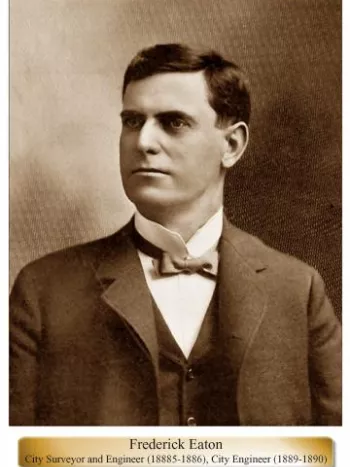
Frederick Eaton, the sixth Anglo child to be born in Los Angeles, was the first "Native Son" Engineer. He was born in a small adobe home, which stood at what is now the intersection of First and Spring Streets. The building in which he was born sometime later was to become the first City jail. His parents were Judge Benjamin S. Eaton and Mary (Hays) Eaton who had come to Los Angeles in 1849.
Educated in Los Angeles public schools, he later attended Santa Clara (California) College. From early youth he had been interested in civil engineering and while being formally educated in the subject, he worked for the city surveyors and engineers in the transitional period of Los Angeles from Spanish to American.
When he was 14, he entered a competition sponsored by the City and won $100 for his original design to reconstruct the Old Plaza, a design that later was to be generally followed when the work was done.
At the age of 19, he married Helen Burdick, member of another pioneer family, and moved to a two-acre farm at Second and Spring Streets. Along with gardening and raising live stock, he continued his engineering education and eventually opened an engineering office.
Mr. Eaton contributed much to the development of Los Angeles. He assisted in mapping and defining city property and was himself appointed city surveyor and engineer in 1885 for one year. In 1889 and 1890 he served as City Engineer, the office of City Surveyor having been abolished. During this incumbency, he designed a sewer system that was the nucleus of today's modern system.
He was the superintendent of privately owned Los Angeles Water Company, and also Chief Engineer for the Los Angeles Railway Company, in which this position he built the first electric railway in the city which was one of the first attempts made in the United States to propel cars with electricity. In 1898, he began a two-year term as Mayor.
Also, in the course of his public activities he became interested in establishing a park system and was credited with having planned every park in the city (as of 1934) with the exception of East Lake. Pershing Square grew from plans he proposed. He also purchased the old home of Cyrus Burdick in 1873 at the northeast corner of Second and Spring Streets where he built the Burdick Block, one of the first modern business blocks in the city.
Both before and after his mayoralty administration, Mr. Eaton made an extended and intensive study of the water supply of Southern California and the future needs of Los Angeles. Some time in 1892, he had journeyed into Inyo County and the High Sierras investigating land and water resources. After leaving public office in Los Angeles, he moved to Long Valley, Mono County and established a ranch which henceforth was to be his home. In 1906, he incorporated the Owens River Land and Cattle Company, later changed to the Eaton Land and Cattle Company, with twelve thousand acres original holdings.
With the eye of an engineer, Mr. Eaton saw the inexhaustible supply of snow waters of the Sierras, which fed the Owens River, that in turn formed the unfathomed basin of Owens Lake and was a possible future source of water supply for the City of Los Angeles. As events developed, he was to be the pivotal figure in the original project to acquire the city's present water system.
Known as the "Father of the Los Angeles Aqueduct", he was the man who laid before the water commissioners the plan for securing possession of Owens River. Prior to this, he had gathered options on riparian properties to further the project, which he later offered to the city at no profit to him.
In 1902, Mr. Eaton was associated with William Mulholland, then chief engineer of the Los Angeles City Water Works, in a water distribution plan. Together they journeyed over the previous routes investigated by Eaton, while Eaton expounded his idea that water from Owens River could be conducted over mountains and deserts by tunnels and siphons to Los Angeles, two hundred and fifty miles away. In the subsequent surveying, designing, and building of the aqueduct Mulholland remained the acting head.
The city of Los Angeles eventually acquired Eaton's ranch properties to be used as the basis greater extension of water development.
Mr. Eaton retired from active participation in the affairs of the Eaton Land and Cattle Company in 1924 because of ill health. The years preceding his death were spent at the home of his son Burdick in Los Angeles, where he died March 11, 1934.
Sources:
Newspaper Clippings
R92, E14, VF Municipal Reference Library Chronological Record of Los Angeles City Officials: 1850-1938, Municipal Reference Library.